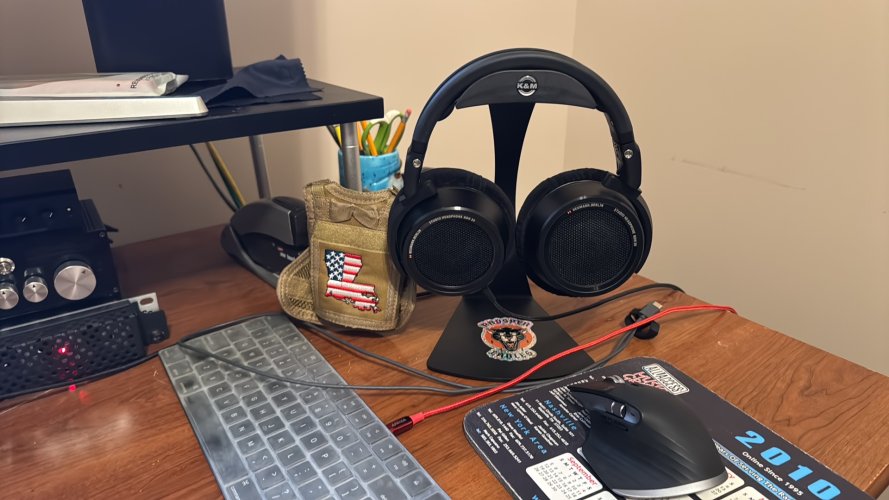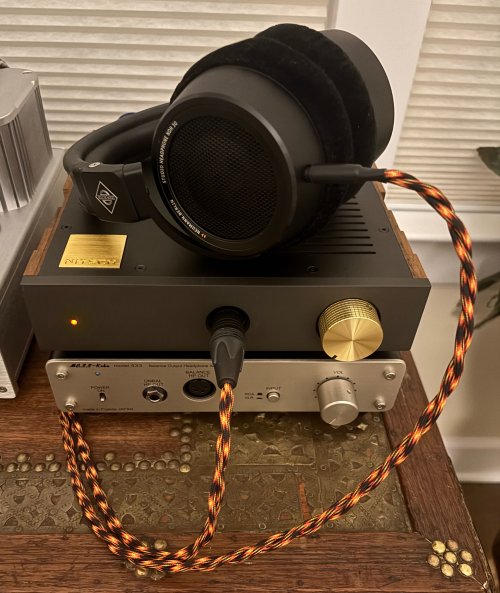I've seen a few announcements for these, but not much media presence, unlike their saturation approach with the NDH 20. These are designed for use as studio monitor on the go. The Neumann acoustic engineers created the open back of their studio monitors in the NDH 20 form factor. Neumann has said that their engineers worked independently from their parent company (Sennheiser) but based the NDH 20 on the HD650. I hope the NDH 30 improves on the NDH 20 by taking advantage of the potential in the open back design.
I'm sure they're also made in China like the NDH 20. Check out this video by Custom Cans to learn about the design and construction of the NDH series. I admire the design more than the sound but looking forward to an open back take on the NDH line.

Its high-quality construction of spring steel and aluminum as well as its pleasant handling properties are largely the same as those of the NDH 20. However, the NDH 30 is an open-back headphone, which means that its dynamic 38 mm transducers work as acoustic dipoles. This allows their highly refined sound characteristics to unfold optimally: extremely fast transient response, dry bass, uncolored mids and transparent highs. In other words, the NDH 30 has no sound coloration, but reproduces the signal 1:1.
The spatial resolution is impressive. The NDH 30 allows razor-sharp localization in the stereo panorama and makes the depth of the mix evident. To minimize channel crosstalk, the NDH 30 is supplied with a high-quality, cloth covered cable that is internally balanced.
To my eye, the looks of the NDH30 aren't quite as striking as the NDH 20, the black grill isn't as striking as a pattern lasercut in the flat back of the NDH 30 would be. I like the sound of the NDH 20 but hope the NDH 30 is tuned more like the Sennheiser HD560/HD400 Pro. For those that haven't opened their NDH 20, the driver is sealed into a shallow flat housing with the majority of the cup being used as a resonance chamber. I'm sure it took a great deal of reworking to make it into an open-back. It looks a bit like the Sennheiser shaped back but knowing the construction of the NDH 20 makes me wonder if they're not semi-open like the Beyer DT880.

Frustratingly, looks like they're the same locking 2.5mm connector. I don't think they need to be balanced given the power requirements, but it would be nice if they dropped the 2.5mm. I wish they'd dropped the special cable and gone with a balanced 3.5mm single side non-locking connector - working with these as portable reference sound, I'm far more likely to trip over a long cable or need to swap to a mobile one for my travel DAC/Amp, so why make it both 2.5mm and proprietary locking connector. I give the NDH series a special exception for their use of right side cable entry as I work left handed and interfaces often have their cables on the right side. All other headphones must be left entry, the only true single-side entry.

Interesting that the pads seem more like Suede than the NDH 20's velour. I'm not not a huge fan of the stock pads on the NDH 20, but I haven't found good replacements. I'm still working on a new design for the headband padding since it's designed to be a very easy replacement and I find the padding lackluster to ineffective.

I'll continue to update with more information as we go.
I'm sure they're also made in China like the NDH 20. Check out this video by Custom Cans to learn about the design and construction of the NDH series. I admire the design more than the sound but looking forward to an open back take on the NDH line.

NDH 30 Studio Monitor
THE PORTABLE SOUND REFERENCE
The NDH 30 is a circumaural, open-back headphone with outstanding detail resolution and high-precision stereo imaging with razor-sharp localization. Its linear soundstage and superior transient response recommend it for the most demanding applications such as mixing and mastering.PERFECT MONITORING IN NEUMANN QUALITY – EVERYWHERE
The NDH 30 was developed with the aim of making the reference sound of a Neumann studio monitor setup, perfectly calibrated via MA 1, available everywhere in the form of an easily transportable headphone. At the same time, the NDH 30 forms its own sound reference in terms of headphone reproduction, which has become a key to success with the consumer. Its superior sound characteristics make the NDH 30 the first choice for mixing and mastering. Thanks to its high long-term comfort, it is just as excellently suited to high-precision editing.Its high-quality construction of spring steel and aluminum as well as its pleasant handling properties are largely the same as those of the NDH 20. However, the NDH 30 is an open-back headphone, which means that its dynamic 38 mm transducers work as acoustic dipoles. This allows their highly refined sound characteristics to unfold optimally: extremely fast transient response, dry bass, uncolored mids and transparent highs. In other words, the NDH 30 has no sound coloration, but reproduces the signal 1:1.
UNCOMPROMISING PRECISION
The NDH 30 owes its superior linearity, among other things, to frequency-selective absorbers that eliminate the overemphasis in the high frequencies that leads to incorrect mixing decisions in many other headphones. For example, the NDH 30 will accurately reveal whether a voice sounds muffled or needs a de-esser.The spatial resolution is impressive. The NDH 30 allows razor-sharp localization in the stereo panorama and makes the depth of the mix evident. To minimize channel crosstalk, the NDH 30 is supplied with a high-quality, cloth covered cable that is internally balanced.
PART OF A SUCCESSFUL FAMILY
With its high linearity and detail resolution, the NDH 30 is perfectly compatible with a loudspeaker system that has been optimally calibrated using Neumann Automatic Monitor Alignment. Mixes begun at home or on the road using the NDH 30 can be seamlessly continued in the studio using KH-Line loudspeakers – and vice versa. At the same time, the NDH 30 is recommended as a headphone sound reference; headphones, after all, have long become the dominant playback system among consumers. The NDH 30 is ideal for checking headphone compatibility and creating binaural mixes of immersive content (including VR and gaming). As consistency and reliability are essential in mixing and mastering, the NDH 30 is manufactured to extremely tight tolerances so each headphone sounds exactly the same.FEATURES
- Outstanding linearity and transient response
- High spatial resolution
- Sound and mix compatibility with KH-Line speakers
- High long-term comfort
- Internally balanced, cloth covered cable (detachable)
- Foldable for easy transport
My Speculations
I'm looking forward to hearing more about these but I'm not compelled to buy them. I'm a fan of the NDH 20 for tracking and mixing but not mastering (they have minimal sound leak, not as objective as claimed but fairly representative of sound). The NDH 20 are a bit of a fashion statement and help people take what their hearing more seriously than the Beyer DT770. It's like how singers put more into their performance if you put a large diaphragm condenser mic in front of them but record them using a small diaphragm condenser side. I'm sure the sides of the NDH 30 will also not perform very well on camera with a green screen or with background blur filters.To my eye, the looks of the NDH30 aren't quite as striking as the NDH 20, the black grill isn't as striking as a pattern lasercut in the flat back of the NDH 30 would be. I like the sound of the NDH 20 but hope the NDH 30 is tuned more like the Sennheiser HD560/HD400 Pro. For those that haven't opened their NDH 20, the driver is sealed into a shallow flat housing with the majority of the cup being used as a resonance chamber. I'm sure it took a great deal of reworking to make it into an open-back. It looks a bit like the Sennheiser shaped back but knowing the construction of the NDH 20 makes me wonder if they're not semi-open like the Beyer DT880.

Frustratingly, looks like they're the same locking 2.5mm connector. I don't think they need to be balanced given the power requirements, but it would be nice if they dropped the 2.5mm. I wish they'd dropped the special cable and gone with a balanced 3.5mm single side non-locking connector - working with these as portable reference sound, I'm far more likely to trip over a long cable or need to swap to a mobile one for my travel DAC/Amp, so why make it both 2.5mm and proprietary locking connector. I give the NDH series a special exception for their use of right side cable entry as I work left handed and interfaces often have their cables on the right side. All other headphones must be left entry, the only true single-side entry.

Interesting that the pads seem more like Suede than the NDH 20's velour. I'm not not a huge fan of the stock pads on the NDH 20, but I haven't found good replacements. I'm still working on a new design for the headband padding since it's designed to be a very easy replacement and I find the padding lackluster to ineffective.

Technical Specifications:
| Frequency Range | 12 ... 34,000 Hz |
| Packed cube | 0.005 m³ |
| Wearing style | Headband |
| Foldable | Yes |
| Ear coupling | Circumaural |
| Acoustic principle | Dynamic open |
| Transducer diameter | 38 mm |
| Transducer magnet | Neodymium |
| Transducer protection | Cloth covered grille |
| Nominal Impedance | 120 Ohms |
| Sensitivity at 1 kHz/1 Vrms | 104 dB SPL |
| Max input power handling | 1000 mW |
| Continuous input power handling | 200 mW |
| THD at 1 kHz and 100 dB SPL | <0.03% |
| Cable entry | Single sided, right ear cup |
| Connectivity | 3.5 mm (1/8") TRS jack plug (straight), adapter for 6.3 mm (1/4") |
| Cable length | 3.0 m (10') |
| Ear cup contact pressure | 5.5-6.8 N |
| Weight excluding cable | 352 g |
| Detachable cable | Yes |
| Replaceable earpads | Yes |
| Colours - headband | RAL 9006 White Aluminium / RAL 7016 Anthracite Grey |
| Colours - ear cups | RAL 9006 White Aluminium |
| Materials - headband | Spring steel strip, aluminium and plastic fittings, plastic trimming |
| Materials - ear cups | Aluminium |
| Materials - ear pads | Cloth covered memory foam |
| Packed dimensions (height x width x depth), mm | 245 x 255 x 84 mm |
| Packed weight | 0.97 kg |
| Operating Conditions | +5° C to +45° C, <90% RH; non condensing |
| Transport/Storage Conditions | -15° C to +70° C; <90% RH; non condensing |
I'll continue to update with more information as we go.
Last edited:






















